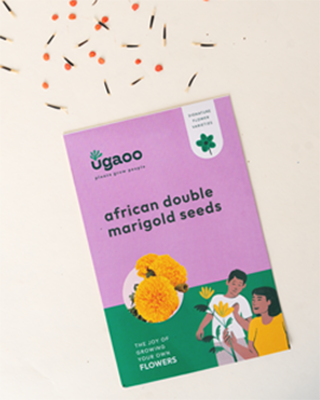The Madhu Kamini plant, scientifically known as Murraya paniculata, is a beloved garden shrub possessing more than just ornamental value. This evergreen shrub is a local of the Indian subcontinent and China and is often used as a supporting plant in gardens.
Buy Flowering Plants
But what makes the Madhu Kamini special and why is it a must-have for gardens?
• Know More About Madhu Kamini Plant
1. Great Plant for Landscaping
Also commonly called the Orange Jessamine or Mock Orange, this bushy shrub is scientifically called the Murraya paniculata. It displays thick, dense, and fast-growing foliage. Its leaves react well to extensive pruning, making the Madhu Kamini a great shrub for many landscape gardens that need an easily manageable and compact plant, capable of being shaped according to preference.
2. Aesthetic and Easy to Maintain
This pretty flowering tree is relatively easy to maintain, grows fast, and boasts wonderful leaves adorned with pearly white flowers. Its appearance adds greatly to its charm and ornamental value, while its ability to grow in various environments makes it an absolute crowd-pleaser. However, interestingly enough, its ornamental value is not all that the Madhu Kamini plant is celebrated for. It has medicinal properties and uses that make it a renowned herb in the world of traditional medicine.
Let’s delve deeper into the world of Madhu Kamini and get to know this fascinating healing plant better!
• A Brief History of Murraya paniculata or the Orange Jasmine
If you’ve been under the impression that the Madhu Kamni is a plant just recently discovered for its many benefits, we really have to say - think again! Astonishingly, the first records of this flowering shrub date back to the 17th century.
1. Early Documentation
German-born botanist - Georg Eberhard Rumphius - was the first to record and describe this plant. While his writing was first recorded during the late 17th century, it was published much later, posthumously in 1747. However, the first official record of the Murraya paniculata is credited to Swedish botanist Carl Linnaeus, in 1767. He named the plant Chalcas paniculata and wrote about it in a book that he published soon after.
2. Cultural Significance
In ancient times, the Madhukamini plant was widely cherished for its ornamental value and planted in gardens of royal palaces and temples. Its fragrant flowers were also often used in religious ceremonies and traditional rituals. The Madhukamini flower, in Asian culture, is known to symbolize love and prosperity, often being planted near homes to attract positive energy and ward off evil spirits.

• Features and Characteristics of the Madhu Kamini
The Orange Jasmine plant is known for its lovely flowers and fast, easily manageable growth habit. To understand the plant better, let’s first look at some of its defining characteristics:
1. Leaves and Foliage
The Murraya paniculata is known for its bushy and dense growth. When fully mature, this medicinal plant can easily reach a height of 6-20 feet. However, the height and growth pattern of this plant is also largely dependent on how it is grown and pruned.
The leaves of this plant are glossy and dark green, and usually arranged alternately. There’s no doubt that this flowering tree has fragrant flowers but even the leaves of the Madhu Kamini plant give off a wonderful scent when crushed.
2. Pearly White Madhukamini Flowers
The pearly white flowers of this herbal plant are widely known for their alluring fragrance. These flowers usually bloom in clusters and look like small, white, star-shaped ornaments atop a glossy green foliage. These flowers produce the kind of scent that you would really have to smell to believe. They are also often compared to the refreshing and calming scent of orange blossoms. This comparison is what earns the Madhu Kamini its two common names - Orange Jasmine or Orange Jessamine as the fragrance of these flowers is refreshingly citrusy.
Additionally, since the flowers bloom in clusters called panicles, the species is called “paniculata.”
3. Fruits of the Madhu Kamini
Post flowering, the Madhu Kamini plant can often produce and proudly display its small and vibrant berry-like fruits. These fruits boast a bright red-orange color that attracts birds and other wildlife. While these fruits are not typically consumed by us and are often viewed as purely ornamental, in some places, they are still used to produce jams and preserves. Additionally, they are known to have various medicinal properties that we will talk about later!
4. Toxicity
The Madhu Kamini plant is not characteristically known to be toxic as it does not have ’highly’ toxic properties. However, all parts of the plant are known to contain mildly toxic alkaloids. So, it is advisable to be cautious while consuming all parts of this plant.
Despite its mildly toxic nature, the Orange Jasmine plant is one of the most revered medicinal plants and herbs, known for its effects on a wide range of ailments and diseases of the human body. Let’s have a look at some of these benefits that have earned this plant a unique distinction in the world of traditional medicine.
• Orange Jasmine Benefits: What Makes it So Beloved?
The Madhu Kamini plant is often termed as a rare yet very potent medicinal herb. Many cultures around the world, especially those centered around South and Southeast Asia, have recognized and used this as a healing herb for centuries. Here are a few of these Madhukamini plant benefits that will also leave you wanting more:
1. Medicinal Benefits: Madhu Kamini Herb as a Medicine
There are countless Murraya paniculata medicinal uses that make this plant a well-known and widely used medicinal herb. Here are a few of these benefits:

2. Ornamental Benefits

• Uses of Murraya Paniculata Plant: How Are the Benefits Reaped?
The Madhu Kamini plant has been a fundamental component of traditional medicine, particularly in Ayurveda, Unani, and Chinese medicine. Each part of the plant—leaves, bark, roots, and flowers—has unique therapeutic applications. There are multiple ways to consume this plant and its parts for their benefits. However, it is advisable to always consult an Ayurvedic doctor and not self-medicate. There is always a likelihood that the medicine could have a bad reaction when paired with other drugs you may be consuming. To avoid this, it is important that you consult a licensed physician before you start medications for any ailments you may have.
Let’s look at some of the different and commonly seen Madhu Kamini plant uses based on traditional medicine:
1. Toothache Remedy
For this, the main component used is the plant’s leaves. These are crushed to extract the juice following which some drops of the extract are then applied directly to the tooth that hurts.
2. Topical Application for Skin
The leaves of the Madhu Kamini plant are often used to heal wounds and insect bites. You can make a paste from crushed leaves to apply to cuts, bruises, or insect bites to reduce inflammation and promote healing. Alternatively, the leaves can also be boiled in water, cooled, and used as a wash for skin infections.
3. Digestive Tonic
For this, the roots of the Murraya paniculata come into play. The roots are cleared and dried, then ground into a fine powder. This powder is then mixed with warm water or milk and consumed to aid digestion.
4. Aromatherapy
Fresh Madhu Kamini flowers are placed in a bowl of hot/warm water (according to preference) and the steam is inhaled as part of an effective process of aromatherapy. The calming fragrance helps reduce stress and anxiety.
5. Skin Toner
Traditionally, the flowers are steeped and soaked in hot water to create a fragrant infusion. Once cooled, this is then used as a natural skin toner to refresh and rejuvenate the skin.
Many of the traditionally acceptable uses of the Madhu Kamini plant have been debated over time. But there have also been several studies that have successfully proven the benefits and uses of this plant,time and again.
A study published in the Journal of Ethnopharmacology found that extracts from the Madhukamini plant exhibit significant anti-inflammatory and analgesic effects. The study concluded that the plant's compounds, such as flavonoids and alkaloids, are responsible for these properties, supporting its traditional use in pain and inflammation management.
Another research highlighted in the Asian Pacific Journal of Tropical Biomedicine demonstrated that extracts from the leaves and bark of Murraya paniculata plant possess strong antimicrobial activity against various bacterial and fungal strains. This supports the traditional use of the plant in treating infections and promoting wound healing.
Now that you know about Murraya paniculata medicinal uses and benefits, let’s also understand how to grow and care for this stunning flowering, evergreen shrub.
• Madhukamini Plant Care: Basics to Know
As an evergreen shrub or small tree that grows well in various environments, the Madhu Kamini plant is a fairly low-maintenance and fuss-free beauty. This pretty flowering tree does not demand too much of your attention and can thrive with little care. Here are a few basic Madhukamini plant care tips to know:

1. Light Requirements
As an outdoor plant, the Madhu Kamini does well in bright, direct sunlight. This is a hardy plant species that loves to bask in the sun. However, it can also tolerate some time in a shaded area with bright, indirect light.
2. Planting and Soil
The plant thrives in well-draining, fertile soil enriched with organic matter. When planting the Kamini plant, dig a hole twice the width of the root ball and the same depth. Place the plant in the hole, backfill with soil, and water thoroughly.
3. Watering Requirements
The Madhukamini plant requires regular watering, especially during dry periods in the summer season. However, remember to always avoid overwatering as it can easily lead to root rot. Water deeply but infrequently, allowing the soil to dry out partially between waterings. Remember to always make use of well-drained and aerated soil that will allow adequate water retention and drainage.
4. Fertilization
Feed the plant with a balanced, slow-release fertilizer in the spring and summer months, which are predominantly growing seasons for the Orange Jasmine plant. Organic compost or well-rotted manure can also be used to enrich the soil and promote healthy growth.
5. Pruning
Regular pruning is essential to maintain the shape and size of the plant. Prune the plant after its flowering season to remove dead or diseased branches and to encourage new growth. Pruning also helps with enhanced air circulation and reducing the risk of pest infestations.
6. Propagation of the Madhukamini Plant
The propagation of this plant can either be done with Kamini flower seeds or with stem cuttings. For propagation through seeds, collect the seeds from ripe berries and clean them thoroughly. Sow them in a well-draining mix of soil and cocopeat, keeping them in a warm, humid environment. Remember that the germination can take several weeks.
How to grow Murraya paniculata from stem cuttings? Take semi-hardwood cuttings from the Madhu Kamini plant in the late spring or early summer. Dip the cut ends in rooting hormone, like Ugaoo’s Root Shoot Hormone, and plant them in a moist, well-draining potting mix. Keep the cuttings in a humid environment until roots develop.
With these simple tips, you will be able to grow the Madhu Kamini plant in your garden, bringing a medicinal and ornamental delight to your space with ease.
Buy Flower Seeds
• Orange Jessamine Plant Flowering Season
Also known as Orange Jasmine, the Madhu Kamini in India typically flowers from the late spring to early fall months - i.e. late February to early September or late August. The peak blooming period occurs during the warmer months. However, in tropical and subtropical regions, the Orange Jessamine may bloom randomly throughout the year, provided it receives ample sunlight and humidity.
To ensure good flowering, the plant requires well-draining, fertile soil, regular watering, and plenty of sunlight—ideally 6-8 hours of direct sun daily. Fertilizing during the growing season with a balanced fertilizer supports robust blooming. Pruning or deadheading after the main flowering period encourages new growth and better air circulation.
In cooler climates, the Madhukamini can be grown in containers and moved indoors during winter to maintain the necessary warmth and light. Remember that detecting infestations in the early stages is crucial. So, continue monitoring for pests like aphids and spider mites and ensure good environmental conditions which will help maintain the plant’s health and flowering capacity. Overall, with proper care, the Madhukamini plant can provide lush, fragrant blooms that will effortlessly enhance any indoor or outdoor space!
FAQs
1. Is Madhu Kamini an indoor plant?
Madhu Kamini plant is generally an outdoor plant. However, with full sunlight and adequate levels of humidity it can be grown well indoors as well.
2. Does Madhukamini plant give off fragrance?
Yes, the Murraya paniculata plant is known to give off a lovely citrusy fragrance from its pearly white flowers. Also, its leaves also give off a wonderful scent when crushed.
3. What is the purpose of Orange Jasmine?
The Orange Jasmine plant is known for its many medicinal benefits. To name a few, this plant has the following benefits: it helps soothe symptoms of bronchitis and asthma, it eases digestive issues, and helps treat wounds.
4. What is the difference between Madhu Kamini and Kamini?
Madhu Kamini plants are known for their smaller leaves and flowers of a pearly white color. On the other hand, Kamini plants typically have larger leaves and produce white flowers.
















